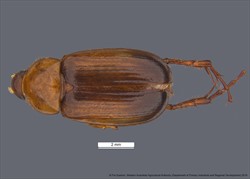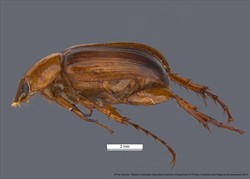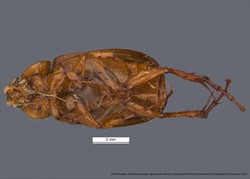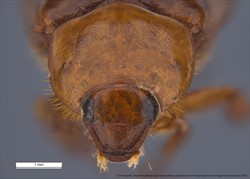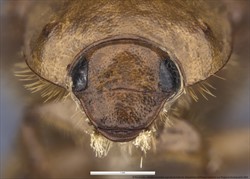Sub family: Melolonthinae / Tribe: Sericini / Genus: Phyllotocus
Fact Sheet
Phyllotocus Fischer, 1823
Small, ovate beetles, body length 4-10mm. Body colouration variable- brown, black, yellowish or bicoloured. Antennae 8-9 segmented, with a 3-segmented club. Surface of frons, clypeus and labrum slightly convex. Labrum attached to apical margin of clypeus, separated by a suture. Posterior angle of the pronotum obtuse or rounded, not closely applied to the shoulders of the elytra. Prosterna with a long, slender, setose process. Metacoxae greatly enlarged. Penultimate ventrite and propygidium separated by a suture. Metatibial apical spurs separated, so that tarsi can move between them. Tarsal segments slender and can be quite elongated, particularly hind tarsi. Inner claw of foretarsi enlarged in males. Tarsal claws simple.
Phyllotocus beetles, or nectar scarabs, are active during the day and commonly found on flowers. They feed on pollen and nectar from native Australian trees, particularly Angophora, Eucalyptus and Leptospermum. Adults of some species are known to swarm, but do not cause damage.
Larvae are soil dwellers, feeding on decaying organic matter.
Phyllotocus are found across Australia, along the east from North Queensland to Tasmania, and across to South Australia. They have been found across the South West of Western Australia, and northwards to Carnarvon. They are absent from north west WA and the Northern Territory.
P. macleayi has been introduced to New Zealand.
Britton, E.B. 1957. A Revision of the Australian Chafers (Coleoptera: Scarabaeidae: Melolonthinae). London : British Museum Vol. 1 vii 185 pp.
Hangay, G., Zborowski, P. 2010. A Guide To Beetles of Australia. CSIRO Publishing, Victoria, Australia. x + 238 pp.

